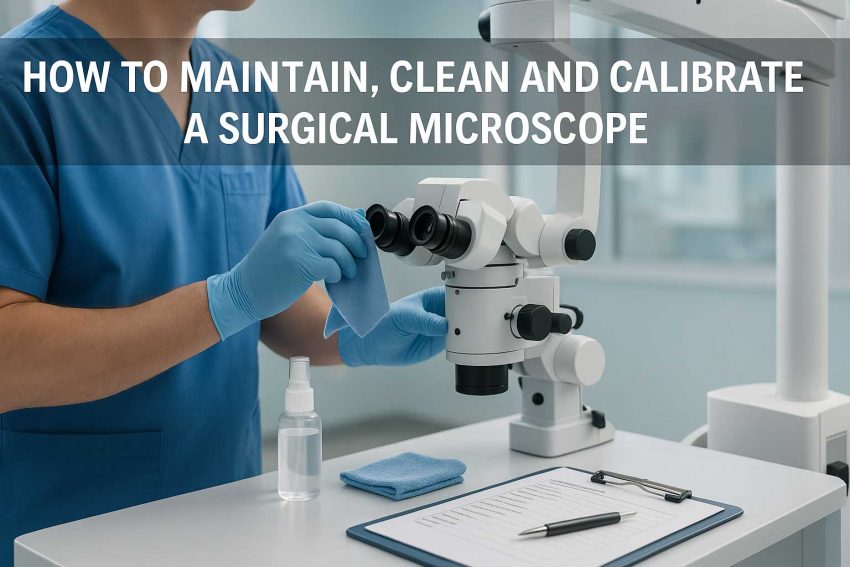How to Maintain, Clean and Calibrate a Surgical Microscope
Proper surgical microscope maintenance is essential to ensure accuracy, extend lifespan, and support sterile environments. Whether used in neurosurgery, ophthalmology, or dental procedures, a well-maintained microscope guarantees consistent performance and optimal visual clarity. In this article, we guide you through the steps to maintain, clean, and calibrate your surgical microscope to ensure optimal clarity, precision, and durability. Follow this expert guide for best practices and step-by-step tips
Why Surgical Microscope Maintenance Matters
A surgical microscope is a precision device. Even minor dirt, misalignment, or mechanical friction can impact image clarity, disrupt procedures, and risk patient outcomes. Proactive maintenance prevents wear, reduces downtime, and protects your investment.
Daily Maintenance Checklist
Before and after each use, follow this daily care routine:
- Visual inspection: Check the body, cables, and optics for any signs of damage, dirt, or residue.
- Clean external parts: Use a soft, lint-free cloth and approved disinfectant wipes to clean handles, knobs, and the outer surface.
- Protect the optics: Always place a dust cover over the microscope after use.
- Verify the light system: Ensure the illumination (LED or Xenon) works without flicker or delay.
How to Clean Surgical Microscope Lenses
Proper cleaning of microscope optics prevents damage and ensures crystal-clear imaging:
- Turn off and unplug the microscope before cleaning.
- Use a bulb blower or soft brush to remove dust from the lens surface.
- Apply a few drops of lens-cleaning fluid to lens paper (never directly to the lens).
- Wipe gently in a circular motion from center to edge.
- Repeat if needed using a clean section of paper until the lens is spotless.
Pro Tip: Avoid cotton swabs or rough cloths, which may scratch lens coatings.
Weekly and Monthly Maintenance Tasks
Depending on frequency of use, add the following tasks to your schedule:
- Internal optics check: Inspect internal lenses using a test image or calibration slide.
- Clean filters and diaphragms: Gently remove and wipe optical filters and light-shaping diaphragms.
- Lubricate joints and moving parts: Use only manufacturer-recommended lubricants to reduce mechanical friction.
- Tighten connections: Ensure all screws, knobs, and eyepieces are secure but not over-tightened.
How to Calibrate a Surgical Microscope
Microscope calibration ensures the view is sharp and measurements are accurate. Here’s how to do it:
1. Adjust Eyepiece Diopter
- Set both eyepieces to 0 and focus on a calibration target.
- Adjust the left and right diopters individually until the image is equally sharp in both eyes.
2. Center the Image
Use the stage and optical centering knobs to align the visual field correctly with your subject.
3. Verify Magnification
Ensure the magnification indicator matches the actual image size using a stage micrometer or reference grid.
4. Test Light Uniformity
Adjust the light intensity and position to make sure illumination is evenly distributed across the field of view.
Best Practices for Long-Term Microscope Care
- Schedule professional servicing: At least once a year by a certified technician.
- Keep a maintenance log: Record cleaning and calibration dates for warranty and tracking.
- Store in a dry, controlled environment: Avoid high humidity and direct sunlight.
- Use original accessories: Only use manufacturer-approved lens paper, bulbs, and lubricants.
When to Call a Professional Technician
Some issues require professional attention. Contact your service provider if you notice:
- Persistent blur or fog in optics
- Imprecise focus despite adjustments
- Non-functioning illumination even after bulb replacement
- Unusual sounds or resistance during movement
Conclusion
Proper surgical microscope maintenance involves regular cleaning, mechanical checks, and precise calibration. When done routinely, it protects your investment, supports surgical success, and reduces costly repairs. By following the best practices in this guide, your microscope will continue to deliver clear, dependable performance every time it’s used.
For more guides and product reviews, visit our full library at SurgicalScopeHub.com.
